#curassier
Photo
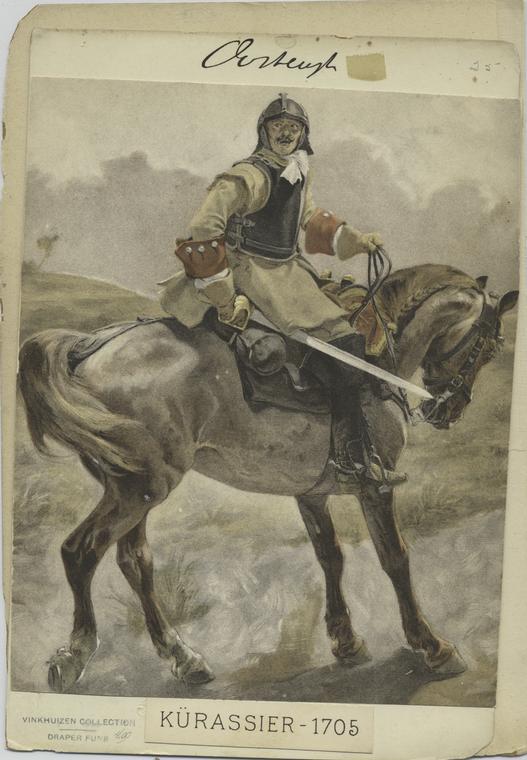
Kürassier, 1705
From: THE VINKHUIJZEN COLLECTION OF MILITARY UNIFORMS, located in the THE NEW YORK PUBLIC LIBRARY DIGITAL COLLECTIONS
#art#military history#curassier#kürassier#Vinkhuijzen Collection of Military Uniforms#New York Public Library
38 notes
·
View notes
Text
guy who's only ever read one literary account of waterloo reading another: getting a lot of les mis vibes from this
#okay only a little. but when hougoumont showed up I did go 'hougoumont!!' out loud.#& w the talk of squares & curassiers & blucher's arrival & the wood etc#<- which is just. like that's just history. but I've only read abt it in the one other place before hence the post ajhhsgh#thoughts#SAD the hollow road isn't here. but I will just have to make do with him making hands out of mud & pulling the cuirassiers down w them
12 notes
·
View notes
Text


Early 17th Century Swept Hilt Rapier
I've had this sword for a couple of months, but I've been slow to post it while learning more about it. When I started out collecting, there were always a couple of dream swords that I'd love to own. On the top of that list were the schiavona and the swept-hilted rapier.
For the most part, rapiers have been out of reach for me. Decent swept hilts command significant money while determining their authenticity is a further challenge that adds unwanted risk. Fortunately, I found a sword within my fiscal comfort zone and quirky enough to attract my attention.
The genesis of rapiers first appeared in 15th Century Spain as a distinctly civilian sword. The progressively improved hand protection resulted in swords equally good in the defence as the offence. This allowed the users to forgo armour and earned these weapons the name espada roperas, 'swords of the robe'. As their use spread, the name mutated. They became known as la rapiere in France and rapier in England.
As so often happens, the term rapier came to encompass a wide selection of swords with various blade profiles. Broadly speaking, rapier describes a large civilian sword for dismounted combat with a complex hilt that offers significant hand protection and a thrust-centric blade. The latter is essential because complex hilts weren't limited to just rapiers; they were mounted on other blades more suited to cutting than thrust-based fencing. As Ewart Oakshott writes, "If you can cut off a man's arm with it, then it's a sword, if not a rapier."
However, as the use of armour declined in the 17th Century, its use peaked, with rapiers making their way onto the battlefield during the latter stages of the Eighty Years' War, where the Dutch fought for independence from Spain; the Thirty Years' War in Germany, and the English Civil War.
By the end of the 17th Century, a new, smaller rapier with its' own form of fencing began to appear in France. It was significantly shorter and lighter than what came before, with an even more specialised thrusting blade. This sword became known as the smallsword and persisted until the end of the 18th Century as the gentleman's sidearm to defend self and honour.


This recent addition to my collection is not an extravagant sword; in fact, it can be better described as 'munitions grade'. The hilt and blade are very functional, robust, and devoid of the decorations and markings usually seen on higher-grade rapiers. It is the type of sword that a musketeer might have worn in the service of one of the many pike and shot armies that fought in the wars that plagued Europe in this era.


Using the A. V. Normans' typology, my rapier has a Type 58 swept hilt and a Type 30 inner guard. According to A. V. Norman, this hilt type appeared around 1560 and remained until about 1635, although my sword likely dates to between 1600 and 1630.
This rapier is a shockingly large weapon. On paper, one and a quarter metres is just a number without real context. But when you stand it against your side and realise it nearly comes up to your chest, it takes on a whole new meaning. The sword is also heavy, a fraction heavier than my French AN XI Curassier swords, which up until now had been my heaviest swords by a good margin.
The sword is in excellent condition, without significant corrosion or other signs of neglect. Only the grip wire is a recent replacement but nicely done in the style of the time, with a Turk's head knot at both ends.


Stats:
Overall Length - 1,245 mm
Blade Length - 1,070 mm
Point of Balance - 75 mm
Grip Length - 153 mm
Inside Grip Length - 100 mm
Weight - 1,340 grams
#swords#antiques#military antiques#17th century#30 Years War#80 Years War#Rapier#Swept hilt#Cut and thrust
68 notes
·
View notes
Text

Just finished up the first batch of 1st Canopian Curassiers. Tried a bit of a chaparral/beach theme for these ones as Canopus looks like it has a lot of water.
66 notes
·
View notes
Text
Io da te non volevo nulla, o forse solo stare bene, nient'altro.
Non pretendevo che curassi le mie ferite e nemmeno che mi insegnassi che non ero capace di sentirmi vivo da solo, che le storie d'amore non sono altro che storie di vita destinate a finire.
Non volevo niente, perchè quando mi sono aspettato qualcosa, la vita mi ha risposto “tanto non succederà”, perchè quando ho provato a essere felice, ho capito che mi sarebbe bastato solo stare meno male.
Perchè quando mi sono innamorato, ho capito che da me si puó solo fuggire.

A. Dikele Distefano
8 notes
·
View notes
Text
And now we arrive at the battle of Rocroi.
My only major gripe with this battle is the French curassiers firing their pistols WAY too far away from the Spanish tercio. Other than that, it's a thing to watch for sure.
4 notes
·
View notes
Text
Che ne diresti se io scrivessi le nostre storie pornografiche e tu le curassi nei minimi particolari arricchendone la trama?
RelaxBeach© (Tutti i Diritti Riservati.) 27/01/2024

2 notes
·
View notes
Text
🔥Io da te non volevo nulla, o forse solo stare bene, nient'altro.
Non pretendevo che curassi le mie ferite e nemmeno che mi insegnassi che non ero capace di sentirmi vivo da solo, che le storie d'amore non sono altro che storie di vita destinate a finire.
Non volevo niente, perchè quando mi sono aspettato qualcosa, la vita mi ha risposto “tanto non succederà”, perchè quando ho provato a essere felice, ho capito che mi sarebbe bastato solo stare meno male.
Perchè quando mi sono innamorato, ho capito che da me si puó solo fuggire... ♠️

(A. Dikele Distefano)
4 notes
·
View notes
Text
Secondo i novax è evidente la correlazione tra i vaccini e il pestaggio🤡
0 notes
Photo
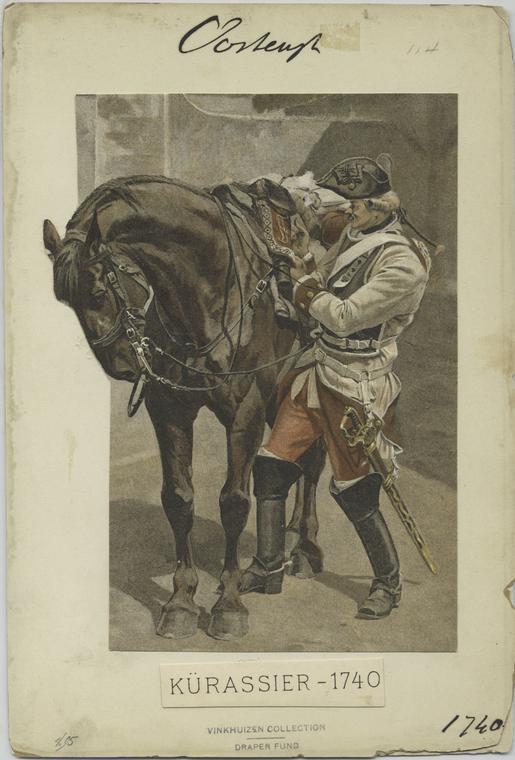
Kürassier, 1740
From: THE VINKHUIJZEN COLLECTION OF MILITARY UNIFORMS, located in the THE NEW YORK PUBLIC LIBRARY DIGITAL COLLECTIONS
19 notes
·
View notes
Photo

Louis, Earl Mountbatten of Burma ‘scratches an itch’ with his aiguillette after parade
#regalia#hat hair#charles#lord mountbatten#aiguillette#aguillette#curassier#medals#scarlets and gold#cavalry#epaulette#breastplate#fun#prince charles#royals#brf#brfamily#royalty
11 notes
·
View notes
Photo
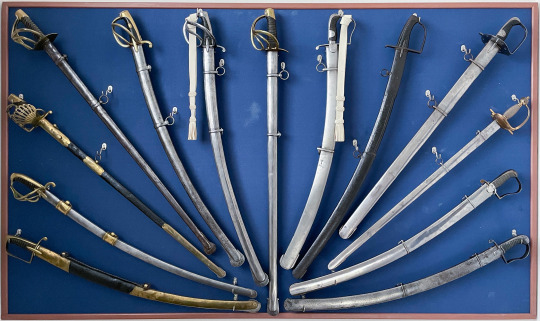
And….. I’ve gone and changed it again. I’ve added the new 1788 Pattern Light Cavalry troopers Sabre, moved the 1796 Pattern Light Cavalry officers Sabre over to where the Mameluke was. The Mameluke will go up later on another display. The sword knots on the Dutch swords are reproductions.
They are:
Dutch m1800 Light Cavalry officer’s or NCO’s sabre
French An XI Light Cavalry officer’s sabre
French ‘Garde de Bataille’ Dragoon officer’s sword
French An XIII Heavy Cavalry troopers’ sword
French An XI Light Cavalry trooprs’ sword
Dutch m1813 No.2 Light Cavalry troopers’ sabre
Dutch m1814 No.3 Heavy Cavalry troopers’ sword
British 1796 Pattern Light Cavalry troopers’ sabre (Dutch issued as the 1813 No.1 for light cavalry)
British 1788 Pattern Light Cavalry troopers’ sabre
British 1796 Pattern Heavy Cavalry troopers’ sword
British 1796 Pattern Heavy Cavalry officer’s sword for dismounted service
British 1796 Pattern Light Cavalry officer’s sabre
British 1796 Pattern Light Cavalry officer’s sabre
#My main sword display.#French Cavalry#British Cavalry#Dutch Cavalry#Napoleonic Wars#Georgian Era#Waterloo#antiques#Light Cavalry#Heavy Cavalry#Dragoons#Hussars#Curassiers#French Army#Dutch Army#British Army#French First Empire#United Kingdom#Great Britain#Kingdom of the Netherlands#An XI Sabre#An XI Sword#1796 Pattern#1788 Pattern#Garde de Bataille
52 notes
·
View notes
Note
favorite armor style? mine is probably maximillian and cuirassier
Definitely gothic, I mean
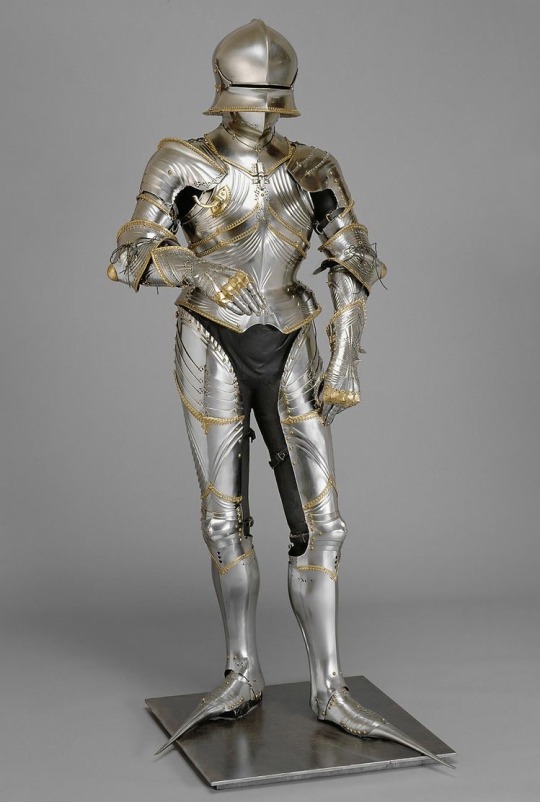
Look at this. Stunning. Beautiful. 10/10.
Maximillian is also pretty neat (I love the fluting!!), and while curassier armour looks a lil weird to my eye (dem legs???) I absolutely have to share what is my favourite curassier art ever:
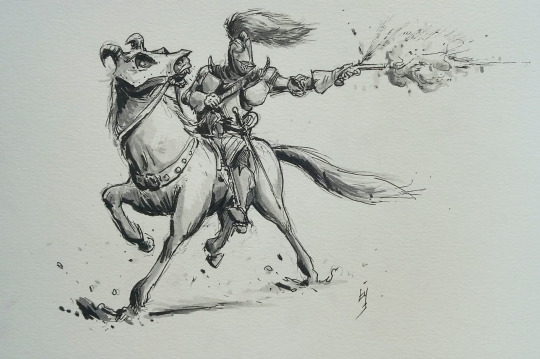
Bang ™
85 notes
·
View notes
Photo
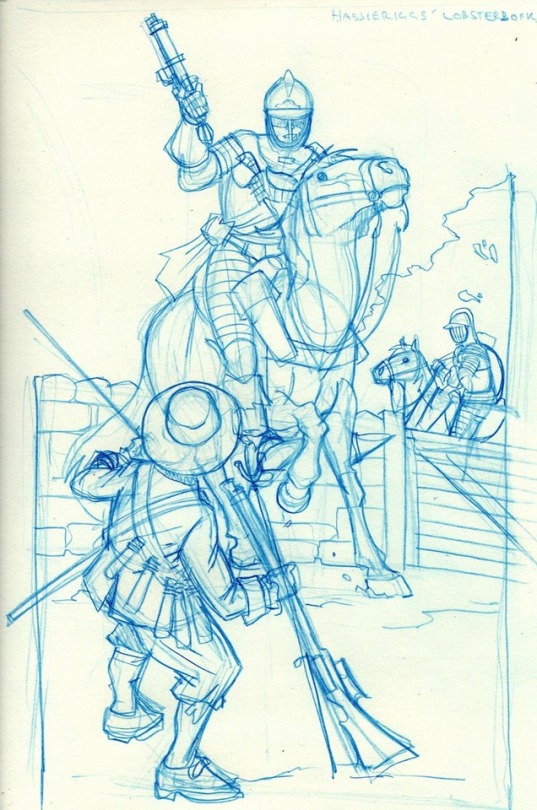
loose English Civil War sketch
16 notes
·
View notes
Text
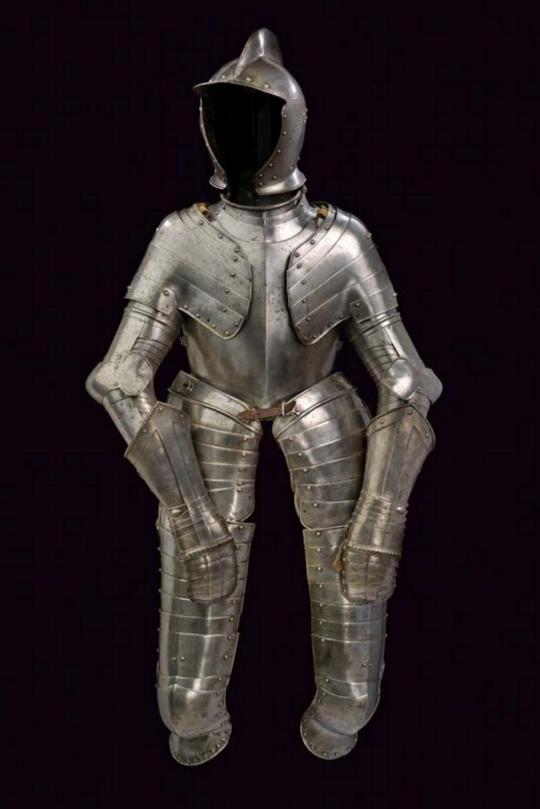
Curassier's half armor, Europe, early 17th century
from Czerny's International Auction House
96 notes
·
View notes
Text
Brickclub 2.1.11 ‘Bad guide for Napoleon, good guide for Bulow’
A short chapter about the moment the tide turns in this battle.
Napoleon squints into the distance and can’t see, quite--he thinks maybe it’s help for him. Others think it’s just trees. In fact, it’s the force that will destroy him. The order is given, and the cannonballs begin to rain down.
And the difference was made by two peasants, one who led the French forces wrongly, the other who gave good advice to the reinforcements for the English. Such are the inscrutable workings of Providence in this book.
seeing the peril Wellington was in, Blücher ordered Bülow to attack and said this remarkable thing: “We must give the English army time to come up for air.”
@synteis has pointed out the huge, discordant contrast between the horror of the human loss and Napoleon’s blithe disregard for it--this catastrophic loss isn’t at all incompatible with success for him. Wellington is maybe half a shade better, looking at the decimated curassiers fighting like centaurs and whispering, “Sublime”--an acknowledgment of other men’s greatness in the face of horrors during his own defeat and a nod to one of the novel’s central themes, vs. Napoleon’s utter disconnection--but he doesn’t see the horror of war and death for what is either.
But in the above quote, someone in charge sees and acknowledges the drowning metaphor that we always come back to in this book. That acknowledgment turns the tide of history.
10 notes
·
View notes